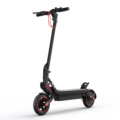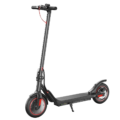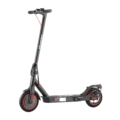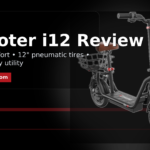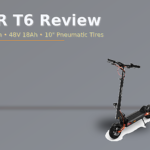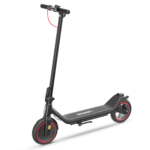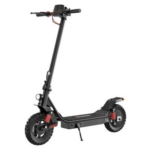- Home
- Scooters
- Electric Scooters
- iScooter F7
iScooter F7
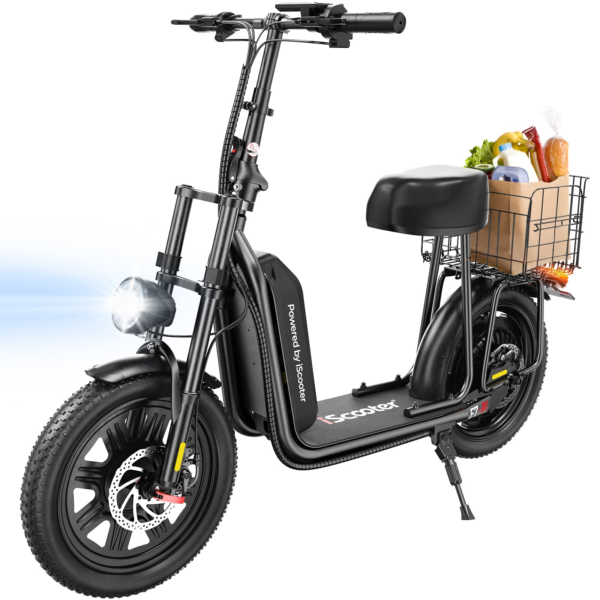

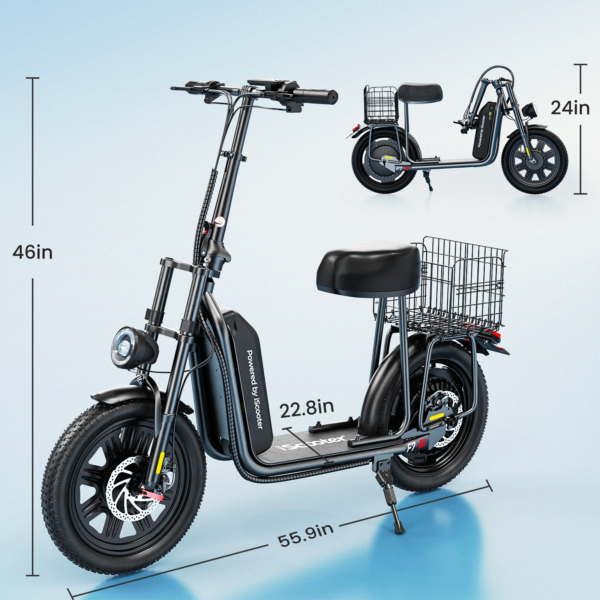

- Battery Range: 40–45 miles (46–72 km)
- Top Speed: 28 mph (45 km/h)
- Motor Power: 1000 W rear hub
- Weight Capacity: 330 lb (150 kg)
- Charging Time: ~7–8 h
- Scooter Weight: 66.68 lb (30.25 kg)
PROS
- 16″ pneumatic tires stability
- Dual disc + electric brake system
- Dual suspension comfort
- RWD traction for hills
- Turn lights for signaling
CONS
- Heavier to carry upstairs
- Air tires need pressure care
- Range varies with speed/grade
- IP rating not listed
Table of contents
- What Is the iScooter F7?
- How the iScooter F7 Works
- Key Specifications
- Design & Build Quality
- Performance Fundamentals
- Battery, Range & Efficiency
- Ride Quality & Comfort
- Braking & Safety Features
- Portability & Daily Usability
- Maintenance & Care
- Weather & Seasonal Considerations
- iScooter F7 vs Alternatives
- Who the iScooter F7 Is (and Isn’t) For
- FAQs
- Glossary (Plain-English)
- Final Setup Tips (Quick Start)
- Why the F7 Works for Everyday Riders
If you want a seated electric scooter with big-wheel stability and simple, low-maintenance running, the iScooter F7 is built for that brief. It blends a 16-inch pneumatic tire format, dual suspension, and a 48V system into a practical, comfort-first package. If you’re cross-shopping models, the iScooter i10 Pro offers a different standing-commuter profile. For campus riders, suburban errands, and relaxed cruises, it aims to be easy to live with—without asking you to become a technician to enjoy it.
What Is the iScooter F7?
At its core, the iScooter F7 is a seated, foldable electric scooter designed around comfort, stability, and everyday practicality. Instead of the small 8.5–10 inch wheels common on stand-up commuters, it runs large 16-inch pneumatic tires. That one choice changes a lot: it smooths rough pavement, settles the steering, and maintains momentum through cracks and patches that would unsettle smaller-wheel platforms.
The F7 also ships with an integrated seat and a foldable front basket, which nudges it toward “utility scooter” territory. You can ride it standing if you prefer, but the frame, cockpit, and suspension are optimized for seated comfort and predictable handling at urban speeds. With dual disc brakes, electronic braking assist, and turn signals, the package reads as a practical personal vehicle rather than a toy.
How the iScooter F7 Works
Think of the F7 as a very compact electric moped with a scooter’s simplicity:
- Motor (rear hub): A 1000W rear hub motor drives the wheel directly. Because it’s a hub, there’s no chain or belt to maintain. When you roll on the throttle, the controller feeds current to the motor windings, producing torque right at the axle.
- Controller (the “brain”): The controller sits between the battery and motor. It regulates how much power the motor receives and when. Picture a dimmer switch for a lamp—more twist at the throttle equals more current, which equals more torque and speed. It also coordinates regenerative braking and communicates with the display/app.
- Battery (48V, 10.4Ah): The battery is the fuel tank. Its voltage (48V) sets the system’s “pressure,” while capacity (10.4Ah ≈ 499Wh) is the amount of energy on board. Higher voltage helps the motor deliver power efficiently. Capacity dictates range; gentle riding stretches it, heavy throttle shrinks it.
- Throttle (hand control): The thumb or twist input sends a request, not a demand. The controller interprets that request based on mode and speed limits. This smoothing is why acceleration feels linear and predictable rather than jerky.
- Brakes (dual disc + electronic): Mechanical discs supply the main stopping force. Electronic braking recovers a bit of energy and adds a gentle “drag” when you roll off or engage braking, smoothing deceleration and easing the load on the mechanical system.
Each piece is simple by itself. Together, they create a predictable, low-drama ride that favors comfort and control over raw aggression.
Key Specifications
| Block | Item | Value |
|---|---|---|
| General | Model | iScooter F7 |
| Form factor | Seated, foldable electric scooter with front basket | |
| Drive | Rear wheel drive | |
| App support | iScooter Club (basic ride data/settings) | |
| Performance & Power | Motor | 1000W rear hub motor |
| Top speed | 28 mph (≈ 45 km/h) | |
| Rated hill grade (manufacturer) | 15° (manufacturer rating; real-world comfort typically on 7–10% grades) | |
| Rider weight limit | 330 lb (150 kg) | |
| Battery, Charging & Electrical | Battery | 48V 10.4Ah ≈ 499Wh |
| Charger | 54.6V 1.5A (approx. 82W) | |
| Charging time | 7–8 hours (empty to full) | |
| Claimed range | 40–45 miles (≈ 64–72 km) | |
| Build & Dimensions | Tire size/type | 16″ pneumatic (air-filled) tires |
| Suspension | Dual suspension (front and rear) | |
| Unfolded (L × W × H) | 49.6 × 23.6 × 45.6 in (≈ 126.0 × 59.9 × 115.8 cm) | |
| Folded (L × W × H) | 49.6 × 23.6 × 42.8 in (≈ 126.0 × 59.9 × 108.7 cm) | |
| Net weight | 66.68 lb (≈ 30.25 kg) | |
| Safety & Control | Brakes | Dual disc brakes + electronic brake system (regen assist) |
| Lighting | Front headlight, rear tail/brake light, turn signals | |
| IP rating | Not specified by manufacturer | |
| Features & Extras | Seat | Integrated (removable for standing ride) |
| Front basket | Foldable (included) | |
| Riding modes | Multi-mode speed presets | |
| Cruise control | Not specified in the official sheet | |
| Warranty & Compliance | Warranty | 12 months (manufacturer) |
| Compliance notes | Rider age 14+, follow local PEV laws; helmet strongly recommended |
Note: Real-world range depends on rider weight, speed, temperature, terrain, and tire pressure.
Design & Build Quality
The F7’s design leans toward real-world practicality. The frame puts you in a neutral, upright posture with the seat centered over the deck area for easy weight shifts. The stem height pairs well with seated riding, and the cockpit keeps the display, throttle, and brake levers within a natural reach. Because the seatpost and basket add structure above the deck, the scooter feels visually and physically more “mini-moped” than a classic stand-up commuter.
Fit-and-finish is utilitarian. Fasteners are exposed where service access matters. The cable routing is straightforward, and the fenders cover a useful arc of the tires, which helps in damp conditions. The 16-inch pneumatic tires and dual suspension soak up road seam chatter, and that alone gives the F7 a calmer ride than most small-wheel scooters. While it folds, it remains long from axle to axle, so folded length doesn’t shrink like a compact commuter. That’s a fair trade for the planted, stable feeling on imperfect pavement.
Because the scooter ships with a seat and a foldable front basket, your day-to-day use changes too. Quick grocery runs, a small backpack, or a laptop bag have a natural home up front. You can still stand and ride, but the package really shines when you sit and cruise.
Performance Fundamentals
Acceleration feel. Roll-on from a stop is smooth and progressive. The F7 doesn’t try to yank you forward with abrupt torque. Instead, it brings you up to speed with measured thrust that feels predictable on bike paths and neighborhood streets. That delivery suits riders who prefer calm control over drama.
Cruising stability. Those 16-inch pneumatic tires are the star of the show. They span cracks, bridge expansion joints with less fuss, and resist deflection when you clip a shallow pothole. As speed builds, the steering stays composed, and the longer wheelbase keeps the chassis from feeling twitchy. You can look farther ahead and relax your grip.
Hill-climb behavior. On rolling 7–10% grades, the F7 maintains momentum in its higher mode without excessive surge or bog. On longer climbs, you’ll still feel speed bleed if you’re near the weight limit or riding into a headwind; that’s normal for single-motor scooters in this class. It recovers quickly once the grade shallows, and the controller’s power delivery avoids the on/off feeling that tires riders out.
Battery, Range & Efficiency
The 48V 10.4Ah battery offers around 499Wh of usable energy. In practice, that’s plenty for daily errands or a mixed commute, especially if you keep speeds moderate. Manufacturers list 40–45 miles (64–72 km) under favorable conditions. Real-world results hinge on several factors:
- Rider weight: Heavier riders need more power to hold speed, especially uphill.
- Speed & mode: Drag rises with speed. Backing off a few mph can add noticeable range.
- Terrain: Frequent hills and stop-and-go riding eat into the battery.
- Temperature: Cold weather increases internal resistance, shaving range.
- Tire pressure: Under-inflated tires increase rolling resistance.
Practical planning. If you routinely aim for the upper end of the claimed range, plan charging windows. If your routes are mixed—say, four to eight miles a day—charging every other day keeps the battery in a comfortable state of charge and reduces full-cycle wear.
Charging best practices. The included 54.6V 1.5A charger takes about 7–8 hours from empty. For battery longevity:
- Avoid storing it fully empty or fully full for long periods.
- If parking for a week or more, leave the battery around 40–60%.
- After wet rides, let the scooter dry before charging.
- Keep the charging area ventilated and the charger off the floor.
Ride Quality & Comfort
Tires and suspension. The F7’s 16-inch pneumatic tires and dual suspension are tuned for comfort. Small bumps blur into the background, and the bigger contact patch adds confidence on patchy asphalt. Because the tires are air-filled, they can be fine-tuned with a floor pump. Set pressure according to the sidewall and your weight; higher pressure sharpens steering and efficiency, while lower pressure adds grip and suppleness.
Ergonomics. Seated posture reduces fatigue on longer trips. The cockpit reach and lever throw feel natural even for smaller hands, and the wider bar gives good leverage at low speeds. Standing is still an option—handy for quick sprints or when you want maximum visibility in traffic—but the scooter’s balance favors seated cruising.
Stem flex and chassis feel. Compared with small-wheel commuters, the longer frame and larger wheels reduce perceived stem flex. Over rough surfaces, you’ll feel a gentle vertical motion from the suspension rather than a skittering hop from the wheels. That translates to less rider bracing and more confidence.
Braking & Safety Features
Braking system. Dual mechanical disc brakes deliver the primary stopping force, with electronic braking adding a mild regenerative assist when you engage the lever. The feel is progressive: initial lever travel builds gentle bite, then ramps to firm deceleration at half-pull. Because the scooter carries more mass than a featherweight commuter, it rewards early, smooth braking rather than late, sharp grabs.
Lighting and visibility. A forward headlight, rear tail/brake light, and turn signals increase conspicuity after dark. For night commuters, consider adding reflective ankle bands or a small helmet-mounted light to project where you look. Wider tires and a longer wheelbase help straight-line stability in low-grip conditions, but braking distances still grow on wet pavement—ride with that buffer in mind.
Weather readiness. The manufacturer does not publish an IP rating for the F7. That doesn’t mean it can’t handle a sprinkle, but it does mean you should avoid heavy rain, standing water, and high-pressure hose sprays. After any damp ride, wipe down the scooter and let connectors dry before charging.
Portability & Daily Usability
Weight and fold. At roughly 66.7 lb (30.25 kg), the F7 is not a “carry up five flights” scooter. It folds to 49.6 × 23.6 × 42.8 inches (126.0 × 59.9 × 108.7 cm), which is long, so it stores best against a wall, in a garage, or in a larger car trunk with the seat removed. For multi-modal commutes that include subways or buses, plan for elevators; shoulder-carrying isn’t realistic for most riders.
Storage and security. The included foldable front basket is practical for errands. When you park, remove valuables and consider a two-lock approach: a U-lock for the frame and a cable for the front wheel/basket area. Bring the charger if you’ll be out all day and expect to top up.
Daily rhythm. If you ride most days, develop a quick pre-ride routine: tire squeeze check, brake lever feel, headlight/turn signal test, and a fastener glance at the stem clamp and seatpost. This 30-second habit prevents minor issues from becoming mid-ride surprises.
Maintenance & Care
A calm, repeatable maintenance routine keeps the F7 feeling new:
Weekly
- Tire pressure: Check with a gauge before your longest ride; adjust per sidewall guidance.
- Brake feel: Squeeze each lever at a standstill. If the bite point moves, plan a cable adjustment.
- Fasteners: Feel for play at the stem clamp, handlebar clamp, and seatpost collar.
Monthly
- Brake pads: Inspect pad thickness; if you’re braking hard often, expect faster wear on the rear.
- Cable condition: Look for frayed or kinked housing; smooth routing preserves lever feel.
- Suspension pivots: Wipe down exposed parts. If squeaks appear, use a light, appropriate lubricant—never on rotors or pads.
Quarterly
- Tire wear and alignment: Check tread and look for embedded debris; spin the wheels to confirm no rotor rub.
- Firmware/app settings: Review mode limits and behavior; confirm that throttle and display are responsive.
- Battery care: Run a balanced cycle (20% → 90%) to recalibrate your sense of range.
After wet rides
- Dry the scooter and let it sit at room temperature before charging.
- Avoid storing it in freezing conditions while damp.
Weather & Seasonal Considerations
Rain. With pneumatic tires and dual suspension, the F7 tracks predictably in light rain, but grip still drops. Increase following distance, brake earlier, and avoid leaning hard on paint lines and metal plates. Because there’s no published IP rating, avoid riding in heavy rain or through puddles that could submerge the motor or connectors.
Heat. In hot weather, lithium batteries dislike extended exposure to direct sun. Park in the shade when you can. During long hill climbs, give the scooter a moment to cool if you notice power tapering.
Cold. Range dips in cold temperatures. Plan shorter loops or a mid-day top-up if you ride below 41°F (5°C). Start gently; cold tires and damp roads reduce early-ride traction.
iScooter F7 vs Alternatives
Against small-wheel commuters. If you’ve tried an 8.5–10″ stand-up scooter and found it nervous on broken pavement, the F7’s 16″ tires will feel like a revelation. You trade compactness and easy stair-carrying for stability, comfort, and seated convenience.
Against performance stand-ups. High-power performance scooters run larger controllers, bigger batteries, and often dual motors. They climb harder and accelerate faster but weigh more and cost more. The F7 is better for measured urban use where range and comfort matter more than peak thrust.
Against off-road models. Off-road scooters bring knobby tires, long-travel suspension, and rugged frames. They shine on trails and rough gravel. The F7 stays on the urban side of the line: smoother tires, simpler hardware, and daily practicality rather than dirt prowess.
In short, the F7 excels when you want stable road manners, a seat, and low-stress operation without the heft and complexity of high-performance or off-road platforms.
Who the iScooter F7 Is (and Isn’t) For
Ideal for:
- Riders who value stability and comfort over compact storage.
- Suburban errands, campus commutes, and neighborhood trips.
- Newer riders who prefer predictable acceleration and composed steering.
- Anyone who appreciates a seat and a usable front basket for daily carry.
Not ideal for:
- Fifth-floor walk-ups where you must carry your scooter daily.
- Riders seeking aggressive acceleration or off-road exploration.
- Ultra-compact public-transit commuters who need tiny folded dimensions.
If your priorities are comfort, calm handling, and practicality—with a seat—you fit the F7’s sweet spot.
FAQs
1) How fast does the iScooter F7 go?
It’s rated up to 28 mph (≈ 45 km/h) on open, flat ground. Always follow local speed rules and ride within your comfort and conditions.
2) What real-world range should I expect?
Plan for a broad band: 20–35 miles (≈ 32–56 km) for mixed riding, more if you cruise gently on flat ground with favorable temps. The rated 40–45 miles assumes lighter loads and conservative speeds.
3) Can I ride the F7 in the rain?
Light splashes happen, but there’s no published IP rating. Avoid heavy rain, deep puddles, and pressure washing. Dry it off and let it warm to room temperature before charging.
4) Does the F7 have cruise control?
The official sheet doesn’t list cruise control. Some app-enabled scooters offer a timed throttle-hold feature; if present, use it only on open, predictable paths.
5) What tire pressure should I run?
Follow the tire sidewall guidance for your weight and load. Check weekly with a gauge. Proper pressure preserves range, steering, and puncture resistance.
6) What’s included in the box?
The scooter, charger, basic tools, a foldable front basket, two battery keys, and a manual. You also get a 12-month manufacturer warranty.
7) Where can I find an “iScooter F7 overview” in one place?
You’re reading one—this article consolidates the essentials and adds practical context for setup, riding, and care.
Glossary (Plain-English)
- Ah (Amp-hours): Battery capacity. Higher Ah = more stored energy.
- Wh (Watt-hours): Voltage × capacity. A better single number for range than Ah alone.
- Controller: The electronic “brain” that meters power from the battery to the motor.
- Regen (regenerative braking): The motor resists wheel rotation to slow you while putting a small amount of energy back into the battery.
- Stem flex: Slight bending or play you can feel at the handlebar stem under load. Less flex feels more precise.
- IP rating: Ingress protection score against dust and water. Not all scooters publish one.
- Pneumatic tire: Air-filled tire; tunable comfort and grip but needs pressure checks.
- Peak power vs nominal: Peak is short bursts; nominal is the typical sustained output.
- Grade/gradient: Hill steepness. Expressed as percent (%) or degrees (°).
- Wheelbase: Distance between wheel axles; longer wheelbases usually feel more stable.
- KERS: Kinetic energy recovery system—another term for regen.
- SOC (state of charge): How full the battery is, usually shown as a percentage.
- Cut-off voltage: The controller’s protective low-battery limit to prevent damage.
- Thermal throttling: Automatic power reduction when electronics get hot.
- Torque: Rotational force from the motor; higher torque helps starts and hills.
Final Setup Tips (Quick Start)
- Unbox & inspect. Confirm that the seat, basket, charger, and tools are present.
- Fastener check. Verify stem clamp, handlebar clamp, brake calipers, and seatpost collar torque.
- Tire pressure. Set according to sidewall. Recheck after the first ride.
- Brake test. At walking speed, apply each lever. Adjust cable slack if the bite point feels vague.
- Charging routine. Top up to 90–100% before your first long ride. Avoid long-term storage at 100%.
- Mode familiarization. Start in a lower mode; learn how the scooter accelerates, brakes, and turns before moving up.
- Security plan. Decide on your locks and storage location before your first errand run.
Why the F7 Works for Everyday Riders
The iScooter F7 focuses on what most people actually do: ride on mixed urban surfaces, carry a small load, and want to feel steady without thinking about every crack in the road. Larger wheels, dual suspension, and dual disc brakes create that easygoing feel. The seat reduces fatigue, and the basket makes short errands painless. You sacrifice compactness and ultra-light weight, but in return you get stability and day-to-day usefulness that smaller scooters can’t match.
If you value comfort, simplicity, and predictable handling, the F7 lands right in the practical sweet spot.
Specifications
General
| Model The Model specifies the exact version or name of the scooter. It helps identify its unique design, features, and specifications within the manufacturer’s product line. Knowing the model makes it easier to compare options, find compatible accessories, or look up support information. | F7 |
| Brand The Brand identifies the manufacturer or company that designs and produces the scooter. A trusted brand is a sign of quality, reliability, and good customer support. Well-known brands often have higher standards for safety, performance, and after-sales service, giving you more confidence in your purchase. | iScooter |
| Release Date The Release Date indicates when the scooter model was officially launched on the market. This helps you know how current the design, technology, and features are. A newer release date often means updated components, improved performance, and the latest safety or smart features. | 17 November 2025 |
| Recommended Age Recommended Age indicates the minimum age range that the scooter is designed for, based on safety, size, and ease of use. Following the recommended age helps ensure that riders can handle the scooter’s speed, weight, and controls comfortably and safely. Always check local laws and use protective gear, especially for younger riders. | Recommended 14+ |
Performance & Power
| Motor Power (Wattage) What it means: The motor power, measured in watts (W), shows how strong the scooter’s electric motor is. Why it matters: Higher wattage usually means better acceleration, more torque, and improved performance on hills or rough terrain. For example, a 250W motor is good for flat city roads and light riders, while a 500W or 1000W motor provides more power for faster speeds or climbing steep inclines. | 1000 W rear hub motor |
| Top Speed The Top Speed indicates the maximum speed that the scooter can reach under optimal conditions. It’s usually measured on level ground with a fully charged battery and an average rider weight. A higher top speed allows you to travel longer distances faster, but always ensure you ride within legal speed limits and your personal comfort zone for safety. | 28 mph (45 km/h) |
| Battery Capacity Battery Capacity refers to the total amount of energy the scooter’s battery can store, usually measured in ampere-hours (Ah) or watt-hours (Wh). A higher battery capacity means you can ride longer distances on a single charge, reducing the need for frequent recharging. Keep in mind that actual range can vary depending on rider weight, terrain, speed, and weather conditions. | 48 V 10.4 Ah |
| Estimated Range per Charge The Estimated Range per Charge indicates the average distance the scooter can travel on a single full battery charge. This range is calculated under optimal conditions, such as flat terrain, moderate speed, and average rider weight. Real-world range may vary depending on riding style, terrain, weather, and load. A longer range means fewer recharges and greater freedom for longer trips. | 40–45 miles (46–72 km) |
| Hill Climb Ability Hill Climb Ability describes the maximum incline or slope that the scooter can handle while maintaining stable performance. It’s typically expressed as a percentage or in degrees. A higher hill climb rating means the scooter can tackle steeper hills without losing too much speed or power. Actual climbing performance may vary based on rider weight, battery charge, and terrain conditions. | 15° slope |
| Drive System The Drive System refers to how power from the motor is delivered to the wheels. Electric scooters typically use either a hub motor (directly integrated into the wheel) or a chain/belt drive system. A high-quality drive system ensures smooth acceleration, efficient power transfer, and low maintenance. The choice of drive system affects performance, noise level, and overall ride experience. | Rear wheel drive (RWD) |
Charging & Electrical
| Charging Time Charging Time indicates how long it takes to fully recharge the scooter’s battery from empty to 100% using the standard charger provided. Faster charging means less downtime and more time on the road. Actual charging time may vary slightly depending on battery capacity, charger output, and environmental conditions. | Approx. 7–8 hours |
| Battery Type Battery Type refers to the specific technology used in the scooter’s battery, which affects performance, lifespan, weight, and charging time. Most modern electric scooters use high-quality lithium-ion (Li-ion) batteries because they offer a good balance of energy density, durability, and low maintenance. A reliable battery type ensures consistent power delivery and longer riding ranges. | Lithium-ion pack |
| Removable Battery A Removable Battery means the battery pack can be easily detached from the scooter for convenient charging and replacement. This feature allows you to charge the battery separately, swap it with a spare for extended range, or securely store it indoors in extreme weather. Removable batteries add flexibility and make it easier to keep your scooter powered up wherever you are. | Non-removable internal battery (fixed pack) |
| Regenerative Braking Regenerative Braking is an energy-saving feature that converts some of the energy normally lost during braking back into battery power. When you slow down or brake, the motor works in reverse to generate electricity, which helps extend the scooter’s range and improves overall efficiency. This system also reduces wear on traditional brake components, leading to lower maintenance over time. | Yes (electric brake system provides regen) |
| Lighting Lighting refers to the built-in front and rear lights that enhance visibility and safety when riding in low-light conditions or at night. Good lighting helps you see the road ahead and ensures that other road users can see you. Many scooters include LED headlights, taillights, and sometimes brake lights or side reflectors for added safety and compliance with local traffic regulations. | Front white light + red tail/brake + turn lights |
Build & Dimensions
| Scooter Weight Scooter Weight refers to the total weight of the scooter when fully assembled, including the battery. This affects how easy it is to carry, lift, and store the scooter when not in use. A lighter scooter is more portable and convenient for commuting, especially if you need to carry it upstairs or onto public transport. Keep in mind that a sturdy frame and quality components may add to the weight but also contribute to better durability and ride stability. | 66.68 lb (30.25 kg) |
| Maximum Rider Weight Maximum Rider Weight indicates the highest rider weight that the scooter is designed to safely support while maintaining optimal performance and stability. Staying within this limit helps ensure reliable acceleration, braking, and climbing ability, and it protects the frame, suspension, and motor from excessive strain. Exceeding the recommended limit may reduce performance and increase wear on components. | 330 lb (150 kg) |
| Deck Size Deck Size refers to the dimensions of the scooter’s standing platform. A wider and longer deck provides more foot space, allowing you to stand comfortably and adjust your stance while riding. A well-sized deck improves balance and stability, especially on longer rides or at higher speeds. Compact decks, on the other hand, help keep the scooter lightweight and portable. | Long wheelbase; stable stance |
| Handlebar Height Handlebar Height refers to the distance from the deck to the handlebars, which affects your riding posture and comfort. An appropriate handlebar height helps you maintain good balance, reduces strain on your back and arms, and makes steering more comfortable. Some scooters have adjustable handlebars to fit riders of different heights, while others have a fixed height for a streamlined design. | Fixed bar height |
| Folding Mechanism The Folding Mechanism describes how easily and securely the scooter can be folded for carrying and storage. A well-designed folding system lets you quickly collapse the scooter into a compact size, making it convenient to transport on public transit, store under a desk, or fit into a car trunk. Look for sturdy latches and safety locks to ensure the scooter stays firmly in place when folded or unfolded. | Quick fold |
| Dimensions Folded Dimensions indicate the size of the scooter when it’s fully folded. This measurement shows how much space the scooter will take up when stored or carried, making it easier to check if it will fit in your car trunk, under a desk, or in a closet. Compact folded dimensions are ideal for commuters who need to bring their scooter on public transport or store it in tight spaces. | Dimensions not specified |
| Material Material refers to the primary construction materials used for the scooter’s frame and key components. High-quality materials like aircraft-grade aluminum, reinforced steel, or durable composites provide strength, stability, and a lighter overall weight. A sturdy material ensures the scooter can handle daily wear and tear while maintaining safety and performance. | Not specified |
Safety & Control
| Brake Type(s) Brake Type(s) describe the braking systems the scooter uses to help you slow down or stop safely. Common brake types include mechanical brakes (like drum or disc brakes), electronic brakes, and foot brakes. Many scooters combine multiple braking systems for added safety and shorter stopping distances. The type and quality of brakes affect your control, especially when riding at higher speeds or on slopes. | Dual disc + electric brake system |
| Suspension Suspension refers to the system that absorbs shocks and vibrations while riding, providing a smoother and more comfortable ride over uneven or rough surfaces. Scooters may have front suspension, rear suspension, or dual suspension for better shock absorption and stability. Good suspension helps reduce rider fatigue and improves control, especially when riding on bumpy roads or off-road paths. | Front & rear dual suspension |
| Tire Type Tire Type refers to the kind of tires the scooter uses, which directly affects ride comfort, traction, and maintenance. Common types include solid (airless) tires, pneumatic (air-filled) tires, or hybrid options. Pneumatic tires offer better shock absorption and a smoother ride on rough surfaces, while solid tires are puncture-proof and require less upkeep. The right tire type helps ensure safe handling and a comfortable ride in different conditions. | Pneumatic tires |
| Tire Size Tire Size indicates the diameter and width of the scooter’s tires, which affect ride comfort, stability, and how well the scooter handles different terrains. Larger tires generally offer better shock absorption and a smoother ride over bumps and rough surfaces, while smaller tires keep the scooter lighter and more portable. Choosing the right tire size helps ensure a balance between agility and comfort. | 16-inch |
| Kickstand The Kickstand is a built-in stand that allows you to park your scooter upright when it’s not in use. A sturdy kickstand keeps the scooter stable and prevents it from tipping over, protecting it from scratches and damage. It also makes storing and accessing your scooter more convenient, whether you’re at home, work, or on the go. | Side kickstand |
| Water Resistance Rating Water Resistance Rating indicates how well the scooter is protected against water and moisture, usually shown as an IP (Ingress Protection) rating. This rating helps you understand whether the scooter can handle light rain, splashes, or wet roads without damage. While most scooters are not fully waterproof, a good water resistance rating adds peace of mind when riding in changing weather conditions. Always avoid deep puddles or submerging the scooter to protect its electrical components. | Not specified |
Features & Extras
| Display/Console The Display (or Console) shows important real-time information about your ride, helping you monitor your scooter’s status at a glance. Typical displays show speed, battery level, distance traveled, and riding mode. Some models also include additional features like Bluetooth connectivity, app integration, or backlighting for better visibility at night. A clear and easy-to-read display enhances safety and convenience on every trip. | LCD screen (official FAQ references auto screen shutoff). |
| Ride Modes Ride Modes refer to the different speed and power settings you can choose to match your riding style or road conditions. Common modes include eco for maximum range and energy efficiency, standard for everyday balance, and sport or turbo for higher speed and stronger acceleration. Switching between ride modes allows you to customize performance, conserve battery, and ride safely in various environments. | No selectable riding modes mentioned in official materials. |
| Smart App Connectivity Smart App Connectivity lets you pair your scooter with a dedicated mobile app via Bluetooth. Using the app, you can monitor real-time ride stats like speed, battery level, and range, adjust settings such as ride modes or cruise control, lock the scooter for added security, and sometimes receive firmware updates. This feature adds convenience and allows you to personalize your riding experience right from your smartphone. | iScooter Club app listed on product page (Bluetooth). |
| Anti-Theft System The Anti-Theft System helps protect your scooter from unauthorized use or theft. This feature can include built-in alarms, electronic motor locks, GPS tracking, or remote locking through a mobile app. A good anti-theft system provides peace of mind when parking your scooter in public spaces, adding an extra layer of security to safeguard your investment. | Keyed battery/ignition lock (package includes 2 keys). |
| Cruise Control Cruise Control allows you to maintain a steady speed without continuously holding the throttle. This feature makes longer rides more comfortable by reducing hand fatigue and providing a smoother, more relaxed riding experience — especially on flat, open roads or bike lanes. For safety, cruise control can usually be easily activated or deactivated while riding. | Cruise control not advertised by the manufacturer. |
| Accessories Included Accessories Included lists the additional items that come with the scooter to enhance your riding experience and convenience. Common accessories may include a charger, kickstand, bell, lights, phone holder, or carrying strap. These extras add value by making your scooter safer, easier to use, and ready to ride straight out of the box. | In the box: F7 scooter, 54.6V 1.5A charger, 4× Allen wrench, open spanner, inner tube, user manual, general safety guide, charging cable, foldable bike basket, 2× battery keys, bicycle pump. |
Warranty & Compliance
| Warranty Period The Warranty Period indicates how long the manufacturer guarantees the scooter against defects in materials and workmanship under normal use. A good warranty provides peace of mind, showing the brand’s confidence in its product quality. Always check what parts are covered, such as the frame, battery, and motor, and follow the maintenance guidelines to keep your warranty valid. | 12 months (region-dependent) |
| Certifications Certifications confirm that the scooter meets specific safety, quality, and environmental standards set by recognized organizations or regulatory bodies. Common certifications may include CE, RoHS, UL, or other local compliance marks, depending on your region. These certifications ensure that the scooter is manufactured to high standards and is safe and legal to use in your country. | Local micromobility compliance |


